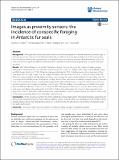Files in this item
Images as proximity sensors : the incidence of conspecific foraging in Antarctic fur seals
Item metadata
| dc.contributor.author | Hooker, Sascha Kate | |
| dc.contributor.author | Barychka, Tatsiana | |
| dc.contributor.author | Jessopp, Mark J | |
| dc.contributor.author | Staniland, Iain J | |
| dc.date.accessioned | 2015-10-01T23:12:40Z | |
| dc.date.available | 2015-10-01T23:12:40Z | |
| dc.date.issued | 2015-09-29 | |
| dc.identifier | 193890101 | |
| dc.identifier | 5e5e860f-a9b1-42aa-af33-c701de5b7611 | |
| dc.identifier | 85018192858 | |
| dc.identifier.citation | Hooker , S K , Barychka , T , Jessopp , M J & Staniland , I J 2015 , ' Images as proximity sensors : the incidence of conspecific foraging in Antarctic fur seals ' , Animal Biotelemetry , vol. 3 , 37 . https://doi.org/10.1186/s40317-015-0083-2 | en |
| dc.identifier.issn | 2050-3385 | |
| dc.identifier.other | ORCID: /0000-0002-7518-3548/work/47136149 | |
| dc.identifier.uri | https://hdl.handle.net/10023/7581 | |
| dc.description.abstract | Background: Although there have been recent advances in the development of animal-attached ‘proximity’ tags to remotely record the interactions of multiple individuals, the efficacy of these devices depends on the instrumentation of sufficient animals that subsequently have spatial interactions. Among densely colonial mammals such as fur seals, this remains logistically difficult, and interactions between animals during foraging have not previously been recorded. Results: We collected data on conspecific interactions during diving at sea using still image and video cameras deployed on 23 Antarctic fur seals. Animals carried cameras for a total of 152 days, collecting 38,098 images and 369 movies (total time 7.35 h). Other fur seals were detected in 74% of deployments, with a maximum of five seals seen at one time (n = 122 images, 28 videos). No predators other than conspecifics were observed. Detection was primarily limited by light conditions, since conspecifics were usually further from each other than the 1-m range illuminated by camera flash under low light levels. Other seals were recorded at a range of depths (average 27 ± 14.3 m, max 66 m). In terms of bouts of dives, still images of other seals were recorded in 5 single dives (of 330) and 28 bouts of dives <2 min apart (of 187). Linear mixed models suggested a relationship between conspecific observations per dive and the number of krill images recorded per dive. Using light conditions as a proxy for detectability, other seals were more likely to be observed at the bottom of dives than during descent or ascent. Seals were also more likely to be closer to each other and oriented perpendicular to each other at the bottom of dives, and in the same direction as each other during ascent. Conclusions: These results are contrary to animal-attached camera observations of penguin foraging, suggesting differing group-foraging tactics for these marine predators. Group foraging could have consequences for models linking predator behaviour to prey field densities since this relationship may be affected by the presence of multiple predators at the same patch. | |
| dc.format.extent | 11 | |
| dc.format.extent | 1650261 | |
| dc.language.iso | eng | |
| dc.relation.ispartof | Animal Biotelemetry | en |
| dc.subject | Pinniped | en |
| dc.subject | Animal-attached camera | en |
| dc.subject | Sociality | en |
| dc.subject | Foraging | en |
| dc.subject | Groups | en |
| dc.subject | Arctocephalus gazella | en |
| dc.subject | QH301 Biology | en |
| dc.subject | SDG 14 - Life Below Water | en |
| dc.subject.lcc | QH301 | en |
| dc.title | Images as proximity sensors : the incidence of conspecific foraging in Antarctic fur seals | en |
| dc.type | Journal article | en |
| dc.contributor.sponsor | The Royal Society | en |
| dc.contributor.institution | University of St Andrews. School of Biology | en |
| dc.contributor.institution | University of St Andrews. Marine Alliance for Science & Technology Scotland | en |
| dc.contributor.institution | University of St Andrews. Scottish Oceans Institute | en |
| dc.contributor.institution | University of St Andrews. Institute of Behavioural and Neural Sciences | en |
| dc.contributor.institution | University of St Andrews. St Andrews Sustainability Institute | en |
| dc.contributor.institution | University of St Andrews. Sea Mammal Research Unit | en |
| dc.identifier.doi | https://doi.org/10.1186/s40317-015-0083-2 | |
| dc.description.status | Peer reviewed | en |
| dc.identifier.grantnumber | en |
This item appears in the following Collection(s)
Items in the St Andrews Research Repository are protected by copyright, with all rights reserved, unless otherwise indicated.

